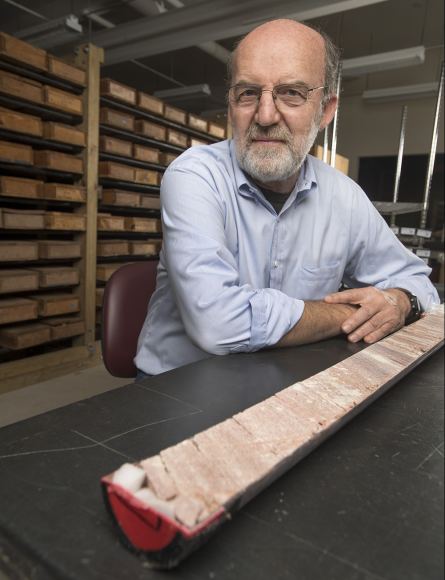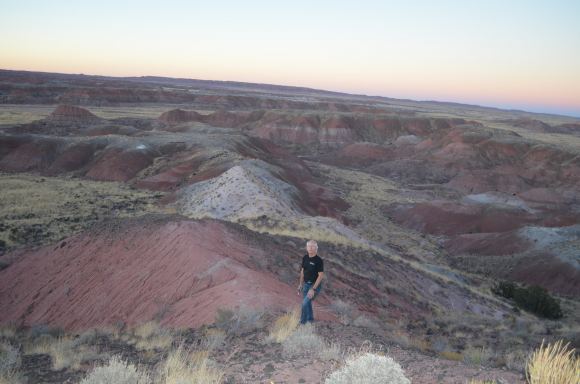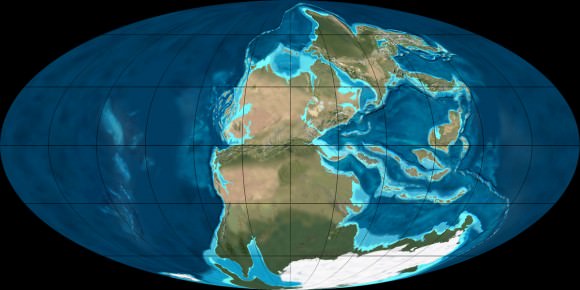It is a well-known fact among Earth scientists that our planet periodically undergoes major changes in its climate. Over the course of the past 200 million years, our planet has experienced four major geological periods (the Triassic, Jurassic and Cretaceous and Cenozoic) and one major ice age (the Pliocene-Quaternary glaciation), all of which had a drastic impact on plant and animal life, as well as effecting the course of species evolution.
For decades, geologists have also understood that these changes are due in part to gradual shifts in the Earth’s orbit, which are caused by Venus and Jupiter, and repeat regularly every 405,000 years. But it was not until recently that a team of geologists and Earth scientists unearthed the first evidence of these changes – sediments and rock core samples that provide a geological record of how and when these changes took place.
The study which describes their findings, titled “Empirical evidence for stability of the 405-kiloyear Jupiter–Venus eccentricity cycle over hundreds of millions of years”, recently appeared in the Proceedings of the National Academy of Sciences of the USA. The study was led by Dennis V. Bent, a, a Board of Governors professor from Rutgers University–New Brunswick, and included members from the Lamont–Doherty Earth Observatory, the Berkeley Geochronology Center, the Petrified Forest National Park in Arizona, and multiple universities.

As noted, the idea that Earth experiences periodic changes in its climate (which are related to changes in its orbit) has been understood for almost a century. These changes consist of Milankovitch Cycles, which consist of a 100,000-year cycle in the eccentricity of Earth’s orbit, a 41,000-year cycle in the tilt of Earth’s axis relative to its orbital plane, and a 21,000-year cycle caused by changes in the planet’s axis.
Combined with the 405,000-year swing, which is the result of Venus and Jupiter’s gravitational influence, these shifts cause changes in how much solar energy reaches parts of our planet, which in turn influences Earth’s climate. Based on fossil records, these cycles are also known to have had a profound impact on life on Earth, which likely had an effect on the course of species of evolution. As Prof. Bent explained in a Rutgers Today press release:
“The climate cycles are directly related to how Earth orbits the sun and slight variations in sunlight reaching Earth lead to climate and ecological changes. The Earth’s orbit changes from close to perfectly circular to about 5 percent elongated especially every 405,000 years.”
For the sake of their study, Prof. Kent and his colleagues obtained sediment samples from the Newark basin, a prehistoric lake that spanned most of New Jersey, and a core rock sample from the Chinle Formation in Petrified Forest National Park in Arizona. This core rock measured about 518 meters (1700 feet) long, 6.35 cm (2.5 inches) in diameter, and was dated to the Triassic Period – ca. 202 to 253 million years ago.

The team then linked reversals in Earth’s magnetic field – where the north and south pole shift – to sediments with and without zircons (minerals with uranium that allow for radioactive dating) as well as to climate cycles in the geological record. What these showed was that the 405,000-years cycle is the most regular astronomical pattern linked to Earth’s annual orbit around the Sun.
The results further indicated that the cycle been stable for hundreds of millions of years and is still active today. As Prof. Kent explained, this constitutes the first verifiable evidence that celestial mechanics have played a historic role in natural shifts in Earth’s climate. As Prof. Kent indicated:
“It’s an astonishing result because this long cycle, which had been predicted from planetary motions through about 50 million years ago, has been confirmed through at least 215 million years ago. Scientists can now link changes in the climate, environment, dinosaurs, mammals and fossils around the world to this 405,000-year cycle in a very precise way.”
Previously, astronomers were able to calculate this cycle reliably back to around 50 million years, but found that the problem became too complex prior to this because too many shifting motions came into play. “There are other, shorter, orbital cycles, but when you look into the past, it’s very difficult to know which one you’re dealing with at any one time, because they change over time,” said Prof. Kent. “The beauty of this one is that it stands alone. It doesn’t change. All the other ones move over it.”

In addition, scientists were unable to obtain accurate dates as to when Earth’s magnetic field reversed for 30 million years of the Late Triassic – between ca. 201.3 and 237 million years ago. This was a crucial period for the evolution of terrestrial life because it was when the Supercontinent of Pangaea broke up, and also when the dinosaurs and mammals first appeared.
This break-up led to the formation of the Atlantic Ocean as the continents drifted apart and coincided with a mass extinction event by the end of the period that effected the dinosaurs. With this new evidence, geologists, paleontologists and Earth scientists will be able to develop very precise timelines and accurately categorize fossil evidence dated to this period, which show differences and similarities over wide-ranging areas.


https://usm.maine.edu/planet/venus-and-jupiter-are-going-be-very-close-together-july-1st-you-wrote-recent-article-will
Venus and Jupiter are just about as far from each other from our point of view as they can…. Jupiter rises in the south-east at sunset (opposition) just as Venus sets in the west… all you need to do is to step outside at dusk to demonstrate that you’re wrong….
Near the end of this article, the author states: “In addition, scientists were unable to obtain accurate dates as to when Earth’s magnetic field reversed for 30 million years of the Late Triassic – between ca. 201.3 and 237 million years ago.” Is this the opposite of what the author meant to say, because why else lead off with “In addition…”?
So where are we in the cycle right now?
The “said Prof. Kent” link appearing just above the map of Pangaea leads to a more detailed article at Phys.Org which quotes the study’s lead author as saying: “the Earth is currently in the nearly circular part of the 405,000-year period”.
Again we are given a mathematical solution and a complete disregard for anything that upsets the apple cart, such as catastrophe or electricity.
How many times has something happened around our little neck of the woods and we have the media saying wow, this only happens every 50 million years or so!! or this is very unusual!!
Velikovsky accurately introduced the idea of Jupiter and Venus influencing the inner solar system, he accurately predicted that Venus is hot and he also predicted that it is rich in hydrocarbons.
The electrical presence in the universe can’t be pushed aside, catastrophe i.e. things that happen out of the blue causing a spanner in the hypothetical mechanistic mathematical and god-driven works, in favour of a nice comfortable regular mathematical formula.
Yes, there are cycles and yes we can sow our seeds by them but no, our solar system has no guarantees and we know nothing unless we question established theories.
Wait a minute….
“The scientists nailed down the Arizona rocks’ ages by analyzing interspersed “volcanic” ash layers containing radioisotopes”
( FROM VOLCANOES WHERE? EARTH, SPACE, THE WASHED DOWN SEDIMENTS, FROM FLOODS? )
that decay at a predictable rate.
( CO2 dating is ineffective over very long time periods.
Potassium-argon depends on the environmental factors during formation, melting, and exposure to decreased pressure and/or open-air ( phrased by wiki ), but here we are establishing environmental factors from the findings.
At the beginning of this paragraph it says that they analyzed scatterings of volcanic ash in a riverbed.
“Within the sediments, they also detected repeated reversals in the polarity of the planet’s magnetic field.”
( _ They were studying Volcanic Ash, but as far as I know, that isn’t magnetic, so the magnetic particles could be chondrites from asteroids etc which fall according to the magnetic field)
“The team then compared these findings to the New York-New Jersey cores, which penetrated old lake beds and soils that hold exquisitely preserved signs of alternating wet and dry periods during what was -believed to be- the same time”